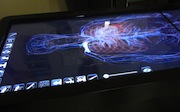A “behind the scenes” visit to the Mayo Clinic Hospital’s high tech training center marked the start of the Phoenix Chapter’s New Year. Michele Halyard, M.D., Vice Dean of the Mayo Medical School Arizona campus, greeted the visitors and spoke about their campaign to establish a four-year medical school in Scottsdale.
 In response to changing health care needs and spiraling costs, the Mayo program will focus on the science of health care delivery. It is one of 11 U.S. medical schools to receive a $1 million grant from the American Medical Association for their work to transform medical education. A key theme is “wellness” with preventative health measures as a focus, an approach not previously stressed in medical training.
In response to changing health care needs and spiraling costs, the Mayo program will focus on the science of health care delivery. It is one of 11 U.S. medical schools to receive a $1 million grant from the American Medical Association for their work to transform medical education. A key theme is “wellness” with preventative health measures as a focus, an approach not previously stressed in medical training.
Another goal is to establish a framework for evaluation of medical costs, asking such questions as “does this test really make a difference?” They believe a doctor should have such training to save the cost of unnecessary testing.
The Mayo Clinic Medical School will have a student population of 50 per class and a student-faculty ratio of 13 to 1. Use of innovative technology and web-based resources, methods not previously used by medical schools, is planned. Mayo is working with ASU to develop a blended curriculum, making it possible for students to earn a Certificate of Science in Health Care Delivery.
Dr. Halyard explained that a launch date for construction of the new Mayo Medical School depends upon completion of the current fundraising campaign, perhaps in the period of 2015-17. Faculty may include professionals from other Mayo facilities as well as those with current ties in the Phoenix community.
Following Dr. Halyard’s presentation, the ARCS visitors toured the Mayo Simulation Lab, visiting lifelike, high-functioning manniquens. These mannequins are used for training in routine medical procedures or programmed to simulate emergency events that might occur with a real patient, enabling staff members to prepare for such situations before they arise. The only thing a mannequin can't do is get up and walk away. Too mention just a few of their life-like qualities - their eyes blink; they have a pulse; blood pressure can be taken, and iv's and catheters can be inserted. Just about any medical situation can be programmed and practiced.
ARCS members practiced hands-on experience with these high-functioning wireless mannequins that are programmed and manipulated from a control room. These mannequins allow users to practice dealing with routine medical procedures or emergencies. Practice events are recorded so that participants can see what they did and learn to respond with best practice. Training is provided for a wide variety of users such as nurses and aides; general service staff; pharmacy; EMT; firefighters; etc.

 The Mayo Sim Center also includes an amazing 3-D state of the art anatomy table at a cost of $ 80,000. It provides a full representation of the anatomy. The patients data can be uploaded and an image can be rotated so that staff can see an areas otherwise not visible. In the few weeks since it's installation, the “Anatomage table” has already solved cases that would not have been possible before.
The Mayo Sim Center also includes an amazing 3-D state of the art anatomy table at a cost of $ 80,000. It provides a full representation of the anatomy. The patients data can be uploaded and an image can be rotated so that staff can see an areas otherwise not visible. In the few weeks since it's installation, the “Anatomage table” has already solved cases that would not have been possible before.
The final rotation through the Sim Center included training with ultrasound equipment. The screen noted what area the members were viewing based on where they placed the ultrasound probe.
All in all it was an exciting visit, and ARCS Phoenix thanks Scottdale Mayo Clinic for this terrific educational field trip.
.
